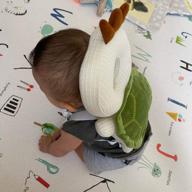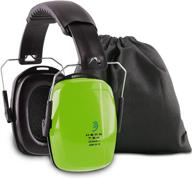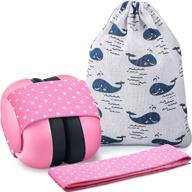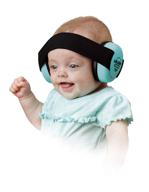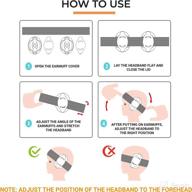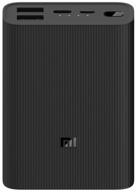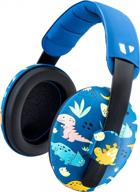Another interesting products
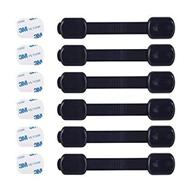

40 Review

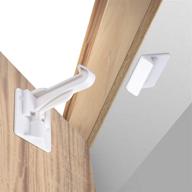

9 Review

Toddler Ear Protection - Safeguard Their Delicate Ears
A toddler's ears are extremely delicate and vulnerable to damage from loud noises. Unfortunately, we live in a noisy world full of potential hearing hazards. From noisy toys to loud TVs to screeching airplanes, a toddler's ears are bombarded daily. As parents, we must take steps to safeguard our little ones' precious sense of hearing.
The Dangers of Noise on Toddler Ears
Prolonged exposure to noises above 85 decibels can permanently damage tender toddler ears. For perspective, normal conversation is about 60 dB, while a motorcycle engine revving is around 95 dB. Toddlers lack the ability to vocalize when noises hurt their ears. They may cover them or cry, but cannot say when sounds are too loud.
Hearing Loss
Noise-induced hearing loss during the toddler years is irreversible. It happens gradually and painlessly over time. The higher the decibel level and longer the exposure, the worse the damage. Hearing loss can impair development of speech, language and social skills.
Other Ear Problems
Extra-loud noises can also rupture toddlers' eardrums. Constant exposure to very loud sounds can trigger tinnitus - a constant ringing or buzzing in the ears. These conditions are extremely uncomfortable and disruptive.
Protecting Toddler Ears
Here are some tips to safeguard your toddler's hearing:
- Use ear protection like earmuffs during loud activities
- Keep the volume low on electronic devices
- Avoid noisy places like concerts and motorsport events
- Choose quieter toys without loud buzzers or sirens
- Lower the volume during tantrums to avoid damage from screaming
Earmuffs are Essential
Well-fitted earmuffs that block out hazardous noise levels are vital for protecting toddlers' ears. Consider earmuffs:
- On airplanes, trains and in cars
- During lawn mowing, leaf blowing or shop work
- At monster truck shows, air shows, races, or fireworks displays
Choose earmuffs specifically designed for toddlers and ensure proper fit. Take breaks from wearing earmuffs to prevent irritation.
Be Proactive
Since toddlers can't communicate ear pain or damage, adults must be proactive. Watch for signs of hearing issues like lack of response to quiet sounds. Consult a pediatric audiologist annually to catch any problems early. Take action now to preserve your toddler's precious sense of hearing for a lifetime.
Selecting the Best Earmuffs for Your Baby's Needs
Protecting your baby's sensitive hearing is crucial during the critical language development years. Earmuffs are an excellent tool to safeguard against damaging noise levels. With so many options available, how do you choose which are right for your infant or toddler?
Key Features of Baby Earmuffs
Here are the most important features to evaluate when selecting earmuffs for your little one:
- Noise Reduction Rating (NRR) - The NRR indicates how many decibels are blocked. Look for an NRR of 20+.
- Fit - Earmuffs should fit snugly around ears without pinching.
- Weight - Lightweight so baby's neck doesn't get strained.
- Comfort - Cushioned, adjustable and not irritating.
- Safety - No detached parts that could pose a choking hazard.
Types of Earmuffs
There are a few main styles of baby earmuffs to select from:
Headband Style
The earmuff cups are connected by a headband that fits around the head. Often adjustable and portable.
Helmet Style
The earmuffs are permanently attached to a plastic helmet. Provides protection beyond just the ears.
Behind-the-Head Style
The headband fits behind the head rather than over the top. May stay on more securely.
| Style | Pros | Cons |
|---|---|---|
| Headband | Adjustable, portable | Can shift out of place |
| Helmet | Added head protection | Less portable, hot |
| Behind-the-Head | Stays on well | Harder to adjust, less portable |
Choose What's Best for Your Lifestyle
Consider your family's routine and noise exposures when selecting earmuff type:
- Frequent airplane travel - portable headband style
- Attending lots of races/airshows - protective helmet style
- Outdoor lawn work - behind-the-head stay-put style
Think about when and where you'll use them most. Try different styles to see what your baby tolerates best.
Prioritize Your Baby's Needs
Your top priority is protecting your little one's sensitive hearing during critical developmental years. Consider these final tips:
- Choose highest NRR available
- Ensure a secure, comfortable fit
- Watch for irritation, discomfort, or distress
- Take breaks from wear every 20-30 minutes
- Discontinue use if any signs of discomfort or hearing issues
Consult your pediatrician with any concerns. With some research and trial and error, you'll find the perfect earmuffs to safeguard your baby's precious sense of hearing.
Top products in 🎧 Hearing Protection Earmuffs
Block Harmful Noises While Allowing Pleasant Sounds In
As parents, we want to protect our babies from damaging noise levels, while still allowing them to hear the pleasant sounds of life. Is it possible to block hazardous decibels while letting in speech and music? Thankfully, the technology exists to do just that.
The Risks of Loud Noises on Infant Ears
Infants' ears are extremely delicate and vulnerable to injury from loud noises. Sounds over 85 dB can permanently damage their hearing. Potential sources of hazardous noise include:
- Fireworks and races
- Concerts and monster truck shows
- Lawnmowers and leaf blowers
- Power tools
- Motorcycle and car engines
- Airplane take-off and landing
Damage occurs cumulatively over time and is irreversible. Protecting their ears is crucial.
Allowing in Pleasant Sounds
While we need to block detrimental noise levels, babies still need to hear normal environmental sounds for healthy development. Important sounds include:
- Speech and language
- Nature sounds and animal noises
- Music and singing
- Regular household noises
Completely muffling all sound can impair auditory development. The goal is blocking hazardous decibels only.
Advanced Electronic Earmuffs
Specialized electronic earmuffs for infants and toddlers allow you to protect their hearing while still letting in balanced, safe sound levels. Features include:
- Noise-cancelling microphones - detect and block loud noises
- Speakers - stream in surrounding ambient sounds at safe volumes
- Volume limiters - cap sound amplification at safe levels
This technology analyzes, filters and balances sounds to remove damaging noise but allow in important audio cues. Your baby can still hear speech and music but be protected from sudden loud noises like a dog barking or dropped pan.
Give Your Baby the Gift of Hearing Protection
Electronic earmuffs are a great way to safeguard your infant's hearing development while exposing them to the pleasant sounds of the world. With the right technology, you can have peace of mind knowing their delicate ears are protected while still picking up the noises they need to hear to grow and learn language skills.
Similar products
Comfort Counts - Find Earmuffs Your Child Will Happily Wear
Getting your toddler to wear protective earmuffs can be challenging. If they aren't comfortable, you'll end up with a screaming, resistant toddler tearing off the earmuffs. The key is finding a pair your child will happily wear for extended periods.
Factors that Impact Comfort
Here are some key considerations for comfortable toddler earmuffs:
- Adjustability - ensure proper fit around the ears
- Cushioning - soft, padded cushions prevent irritation
- Weight - lighter materials reduce neck strain
- Breathability - let heat escape and air flow
- Roominess - avoid pinching the delicate ear
Adjustment Options
Look for earmuffs with adjustable fitting to customize it for your child's head size. Features may include:
- Adjustable headband
- Flexible ear cup joints
- Swiveling ear cups
- Padding inserts of varying thicknesses
You want a snug, secure fit around the ears without it feeling tight and uncomfortable.
Cushioning and Padding
Cushioning prevents the hard plastic from irritating delicate toddler skin. Be sure any foam or padding:
- Completely encloses the ear without pinching
- Feels soft, smooth and breathable
- Is removable and machine-washable
- Is hypoallergenic for sensitive skin
Replace padding periodically as it compresses down over time.
Weight and Materials
Heavier materials quickly make earmuffs uncomfortable for a toddler's developing neck muscles. Seek out:
- Lightweight metals like aluminum
- Durable, flexible plastics
- Thin, breathable padding
Avoid heavy metals, bulky padding or electronics that add weight.
Find Earmuff Harmony
With adjustable, cushioned, lightweight earmuffs made just for toddlers, you can protect their ears without tears or frustration. Prioritize comfort and your child will keep their hearing safe with no complaints.
Save Your Baby's Hearing With Noise Cancelling Earmuffs
Protecting your infant's delicate ears from damaging noise is crucial during early development. Noise cancelling earmuffs are an excellent way to safeguard their precious hearing.
The Threat Loud Noises Pose
Young babies' ear structures are extremely fragile. Exposure to noises above 85 decibels can permanently destroy inner ear hair cells, leading to hearing impairment or deafness. Unfortunately, there are hazards everywhere:
- Airplane and train engines
- Concerts, races, fireworks displays
- Lawnmowers and leaf blowers
- Barking dogs, car horns
- Their own repeated screaming or crying
Hearing damage builds up over time and cannot be reversed. Protecting their developing ears is a must.
How Noise Cancelling Earmuffs Work
Passive Noise ReductionThe physical earmuff structure around the ear blocks out sound waves trying to enter the ear canal. This provides 15-30 decibels of noise reduction. | Active Noise CancellationMicrophones pick up ambient noise and generate opposite sound waves to cancel out and neutralize the incoming racket before it reaches the ear. |
Combining both methods provides maximum protection from damaging sound pressure levels.
Benefits for Baby's Developing Ears
Noise cancelling technology offers many advantages:
- Filters loud bursts like fireworks or barking
- Eliminates the need to turn up volume to override background noise
- Allows parent communication and gentle music to still be heard
- Can be worn comfortably for extended periods
- Reacts instantly to sudden loud noises
This protects delicate inner ear structures while still permitting normal sound exposure needed for growth.
Finding the Best Earmuffs for Your Needs
When selecting noise cancelling earmuffs, look for:
- High noise reduction rating (NRR)
- Active noise cancelling technology
- Snug but comfortable fit
- Breathable, lightweight materials
- Volume limiters for music/speech
- Ability to still hear cries and alerts
Prioritize earmuffs designed specifically for infants and toddlers. Protect your baby's priceless hearing during their most critical developmental years.
Preserve Your Child's Hearing Future
Noise cancelling technology finally allows us to shield baby's delicate ears without missing out on life's important sounds. Don't wait - safeguard your little one's hearing now and give them the gift of sound for a lifetime.
Give Your Child Uninterrupted Sleep By Reducing Disruptive Noises
Children's sleep is easily disrupted by noise. Their developing brains have a low arousal threshold to sounds compared to adults. Finding ways to reduce disruptive noises in the home can lead to better, uninterrupted sleep for your child.
Common Sleep Disrupting Noises
Here are typical household noises that can fragment children's sleep cycles:
- Televisions or radios
- Dogs barking
- Dishwashers or washing machines running
- Flushing toilets
- Siblings playing or fighting
- Doors closing
- Leaky faucets dripping
Ongoing or sudden, loud noises easily rouse children out of deep sleep phases into lighter sleep or wakefulness.
The Importance of Uninterrupted Sleep
Preserving unfragmented, high quality sleep is crucial for children's growth and development. Interrupted sleep can lead to:
- Impaired thinking and learning
- Behavior and emotional issues
- Lack of focus or hyperactivity
- Weakened immune system
- Dark eye circles and yawning
Prioritizing a peaceful sleep environment will improve their sleep quality.
Strategies to Reduce Disruptive Noises
Here are some tips to limit sleep-interrupting noises:
- Turn off TVs and radios
- Use a white noise machine to mask unpredictable sounds
- Install carpet or rugs to absorb noise
- Close doors and windows facing noise sources
- Soundproof their room as much as possible
- Have them wear noise cancelling headphones
- Avoid noisy nighttime activities like loading dishwashers
Be creative and find ways to eliminate or reduce sources of noise pollution in your home at night.
The Gift of Uninterrupted Sleep
Paying attention to noise disruptors and taking steps to minimize them gives your child the gift of consolidated, unimpaired sleep critical for their development. Protect their slumber by reducing disturbances.
"What Are The Best Hearing Protection Earmuffs For Babies?"
According to the search results, here are some of the best hearing protection earmuffs for babies:
- BANZ Earmuffs for Infant Hearing Protection
- Alpine Muffy Baby Ear Protection for Babies and Toddlers up to 36 Months
- BBTKCARE Baby Ear Protection Noise Cancelling HeadPhones for Babies for 3 Months to 2 Years
- Mumba Baby Ear Protection Noise Cancelling Headphones for Babies and Toddlers Baby Earmuffs - Ages 3-24+ Months
- Baby BANZ Earmuffs Infant Ear Hearing Protection – Ages 0-2+ Years Industry Leading Noise Reduction Rating Soft & Comfortable
- LYSIAN Baby Ear Muffs Noise Blocking for Infants with Elastic Headband,Hearing Protection Earmuffs for Sleep, Travel
It is important to note that the best earmuffs for a baby may vary depending on the age of the baby, the size of their head, and the specific needs of the parents. It is recommended to do research and read reviews before purchasing any hearing protection earmuffs for babies.
What Are The Pros And Cons Of Over-Ear Vs In-Ear Hearing Protection Earmuffs For Babies??
Pros of over-ear hearing protection earmuffs for babies:
Cons of over-ear hearing protection earmuffs for babies:
Pros of in-ear hearing protection earmuffs for babies:
Cons of in-ear hearing protection earmuffs for babies:
What Are The Differences Between Over-Ear And In-Ear Hearing Protection Earmuffs For Babies??
Here are the differences between over-ear and in-ear hearing protection earmuffs for babies:
Over-ear earmuffs:
In-ear earmuffs:
It is important to note that the best type of earmuffs for a baby may vary depending on the age of the baby, the size of their head, and the specific needs of the parents. It is recommended to do research and read reviews before purchasing any hearing protection earmuffs for babies.





